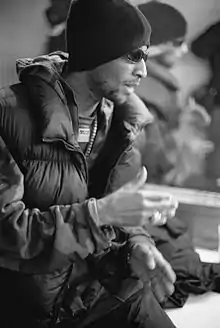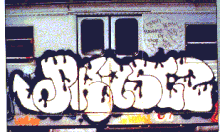Phase 2 (artist)
Michael Lawrence Marrow (August 2, 1955 – December 12, 2019),[1] known as PHASE 2 and Lonny Wood, was an American aerosol paint artist based in New York City. Mostly active in the 1970s, Phase 2 is generally credited with originating the "bubble letter" style of aerosol writing, also known as "softies".
Phase 2 | |
|---|---|
 PHASE 2 in 1999 | |
| Born | Michael Lawrence Marrow August 2, 1955 New York City, U.S. |
| Died | December 12, 2019 (aged 64) New York City, U.S. |
Early life
Born to the late John Thomas Marrow and Adele Crichlow Marrow. He was a native of The Bronx, New York City, and attended DeWitt Clinton High School. Many famous graffiti writers of the early 1970s would meet at a doughnut shop across from the school before heading down to the 149th Street–Grand Concourse station to watch tagged trains on the IRT subway lines pass.[2]
He began writing in late 1971 under the name Phase 2.[3] Part of the appeal of aerosol writing for Phase 2 was that it allowed him to get his "name" known, yet remain anonymous.[4] He noted later that tagging provided disadvantaged urban teens "the only significant vehicle to represent their existence."[5]
Career

In late 1972, Phase 2 first used an early version of the "bubble letter" or "softie", a style of writing which would become extremely influential and is considered a "giant leap" in the art form.[6] The puffed-out, marshmallow-like letters drawn by Phase 2 were soon copied by other artists who added their own variations. Phase 2 quickly embellished on his original form, creating and naming dozens of varieties of softies, such as "phasemagorical phantastic" (bubble letters with stars), "bubble cloud", and "bubble drip".[7] He described the thrill of tagging subway cars as "impact expressionalism".[1] He is also credited with having pioneered the use of arrows in graffiti writing around this same time.[8] Hip-hop journalist Jeff Chang has noted that Phase 2's canvasses from 1973 have "been widely recognized as defining the early genre."[9]
Over time Phase's work become more complex, moving away from the simple tags of the early 1970s to "hieroglyphical calligraphic abstraction."[4] In 1975, he joined the newly created United Graffiti Artists, a professional aerosol writer collective that began to attract media attention. He was featured in an essay on graffiti art by Richard Goldstein, which appeared in New York magazine.[6]
In 1986, Phase 2 became the art director of International Get Hip Times, the first 'zine about aerosol culture.[10]
Phase participated in hip-hop shows organized by Kool Lady Blue during the summer of 1982 at The Roxy in Chelsea, Manhattan. These shows brought together the top DJ's, rappers, break-dancers, and aerosol artists from the South Bronx and introduced hip-hop music and culture to the downtown punk and new wave scenes. Phase 2 designed the flyers for these events and often created aerosol pieces live on stage.[11] He was also part of the first "international" hip-hop tour when stars from the Roxy performances toured in England and France.[12]
In 1982, as part of his involvement with the Roxy scene, Phase 2 released two rap singles. "Beach Boy" was a collaboration with Barry Michael Cooper, who later wrote the script for New Jack City. "The Roxy" featured the Bill Laswell-led group, Material, and Grand Mixer DXT.[13][14]
Phase 2 was also a b-boy and claimed that his dance crew pioneered the uprock (or "battle rock") style of dance, despite claims that it originated in Brooklyn.[13]
Along with Michael Holman, Phase 2 helped form the pioneering break dance crew, The New York City Breakers, and gave the crew their name. Phase 2 made numerous flyers for Holman's hip hop events and many other hip hop events, and was the first person to use the term "hip hop" on a flyer. Holman: "Phase 2 was a good friend and a good person who cared deeply for other people and the culture (hip hop, aerosol/graffiti) he was greatly responsible for creating. He spent a lot of time educating people like me who were eager to learn more about hip hop culture, back in the early 1980s. He will be missed, dearly."
Phase 2 was the first to create a large-scale, three-dimensional graffiti/aerosol sculpture. The piece stood over 6 feet high and was made of brushed steel. The sculpture stood for years in the Jacob Javits Center. It was accidentally removed and destroyed during a reconstruction of the center.
Though he did not have a role in the production, Phase 2 did apparently influence the classic early hip-hop movie Wild Style. In the DVD commentary for the film, director Charlie Ahearn explained that, when thinking about the key character named "Phade", he had Phase 2 in mind. The role was played by Fab 5 Freddy, also a graffiti artist. Phase 2 later worked as a consultant on the 1984 movie, Beat Street.[15]
Personal life
Marrow died on December 12, 2019, at age 64 in New York City, after suffering from amyotrophic lateral sclerosis.[16]
References
- Caramanica, Jon (December 20, 2019). "Phase 2, an Aerosol Art Innovator, Is Dead at 64". The New York Times – via NYTimes.com.
- Castleman, p85.
- "GrAfFiTi". Archived from the original on March 13, 2004. Retrieved September 21, 2007.
- Maizels, John. "Writer of the Storm". Raw Vision. Archived from the original on August 16, 2007. Retrieved September 21, 2007.
- Christen, Richard (Fall 2003). "Hip Hop Learning: Graffiti as an Educator of Urban Teenagers". Educational Foundations. Retrieved September 21, 2007.
- "History, Subway Writing, 1969-89". Retrieved September 20, 2007.
- Castleman, p56.
- Woodward, Jason Dax (June 13, 1999). "How to read Writing". Archived from the original on October 24, 2007. Retrieved September 21, 2007.
- Chang, p153.
- "Graffiti Glossary". Graffiti.org. Retrieved September 21, 2007.
- Chang, 174.
- Chang, 182-84.
- "Interview with Phase 2". Retrieved September 21, 2007.
- "The Bill Laswell Discography, 1982". Archived from the original on September 16, 2007. Retrieved September 20, 2007.
- "Beat Street Behind the Scenes". Retrieved July 20, 2009.
- "Hip Hop Mourns Death Of Legendary Graffiti Writer PHASE 2". HipHopDX. December 12, 2019. Retrieved December 14, 2019.
Works cited
- George, Nelson (2001). Buppies, B-boys, Baps & Bohos: Notes on Post-Soul Black Culture. Da Capo Press. ISBN 0-306-81027-1.
- Chang, Jeff (2005). Can't Stop Won't Stop: A History of the Hip-Hop Generation. Picador. ISBN 0-312-42579-1.
- Castleman, Craig (1982). Getting Up: Subway Graffiti in New York. MIT Press. ISBN 0-262-53051-1.